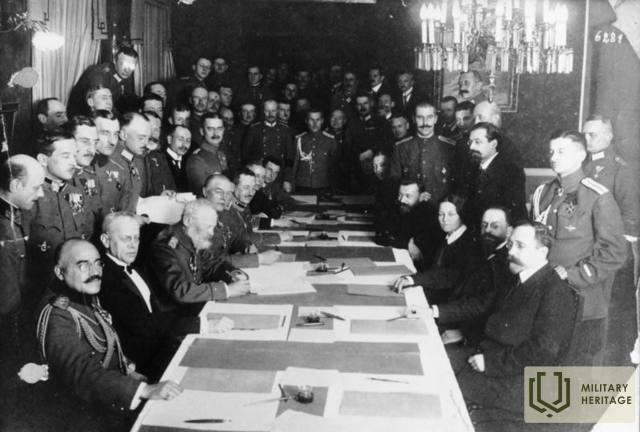Treaty of Brest-Litovsk I World War I

The Treaty of Brest-Litovsk was an international treaty signed on 3 March 1918 in Brest-Litovsk (now Brest, Belarus) between Russia on the one hand and Germany, Austria-Hungary, Bulgaria and Turkey on the other. It ended hostilities on the Eastern Front of World War I, and Russia became the first country to withdraw from the war.
Peace negotiations in Brest-Litovsk had begun in December 1917, but they quickly reached a deadlock, with the two warring parties unable to agree on terms of peace. In February 1918, Germany resumed hostilities on the Eastern Front in order to force Russia to accept the terms dictated by Germany. On February 21, the Germans captured Minsk, on February 25, Tallinn, on February 28, the entire territory of Latvia, and on March 1, Kiev. Realizing that Russia no longer had a combat-ready army, it agreed to conclude a peace treaty on German terms, giving up vast territories in the western part of the former empire. The Brest-Litovsk Peace Treaty provided for Russia to renounce Poland and the Baltic territories, recognize the independence of Ukraine, completely demobilize its army and navy, and pay huge reparations.
The peace treaty concluded recorded Russia's consent, while retaining Latgale, to transfer Courland, Riga and Sāmsala to German rule, but left the question of the future ownership of Vidzeme and Estonia open. The Latvian Provisional National Council was not at peace with this outcome and in March 1918 issued a protest against the division of Latvian territory envisaged in the treaty. According to the Treaty of Berlin (an addendum to the Brest Peace Treaty), which was signed almost half a year later — on August 27, Russia renounced "supreme authority" over Vidzeme and Estonia as well.
In the German-occupied territory of Latvia at that time, the administrative regime was strict, movement was very difficult, for example, a barbed wire fence was erected around Riga, through which electricity was occasionally passed to prevent people from leaving or entering the city of Riga. Living conditions were very difficult, there were trade restrictions, food was rationed, people were mobilized for forced labor.
Despite the victory on the Eastern Front against Russia, the situation of Germany and its allies deteriorated rapidly in the second half of 1918. The Germans were forced to admit defeat and went to France to begin armistice negotiations. On November 11, 1918, the signing of the Armistice of Compiègne, which provided for Germany's renunciation of the Brest-Litovsk Peace Treaty, ended World War I. However, two days later, on November 13, having announced the annulment of the Brest-Litovsk Peace Treaty, Soviet Russia moved the Red Army to the Baltics. Latvia and Estonia were threatened with a new occupation.
More information sources
Latvian Radio 1 program “This Day in the Eyes”, episode “The Brest-Litovsk Peace Treaty”, 2018. Available: https://open.spotify.com/episode/0bTLvFUO7tR07dVbG2qqh9 [accessed: 26.03.2021.].
Šiliņš, J. lsm.lv series #LV99plus or Living History publication “What and why should we know about the Brest-Litovsk Peace Treaty?”, 2018. Available: https://www.lsm.lv/raksts/dzive--stils/vesture/kas-un-kapec-jazina-par-brestlitovskas-miera-ligumu.a270043/ [accessed: 26.03.2021.].
Collection of materials on the November 6, 1998 conference "Latvia and the New States of Europe: 1918 – 1939". Latvian Gazette No. 341/342, 1998. Available: https://www.vestnesis.lv/ta/id/50733 [accessed: 30.03.2021.].




